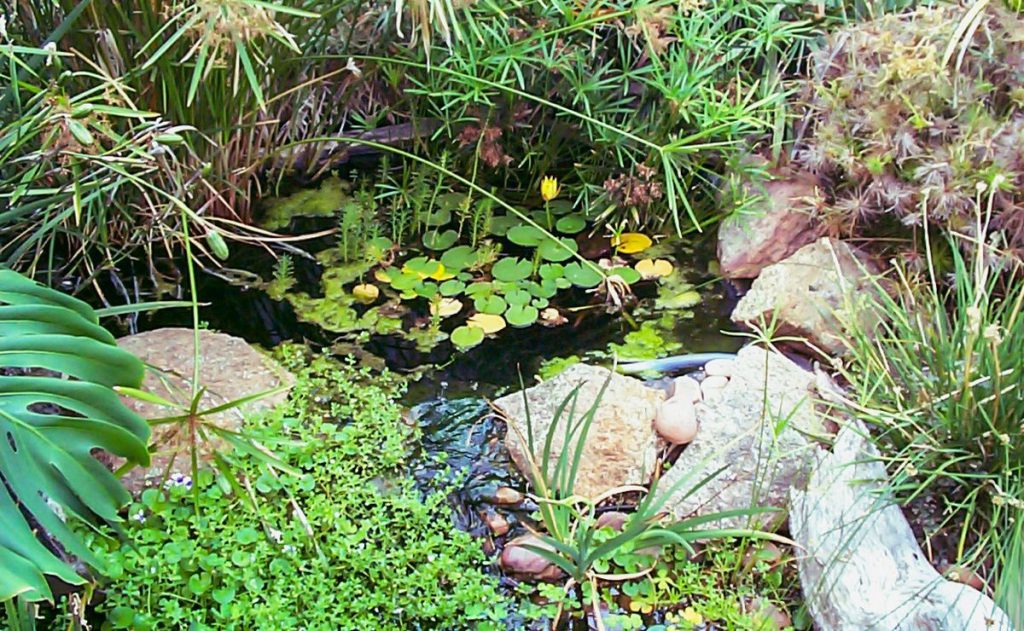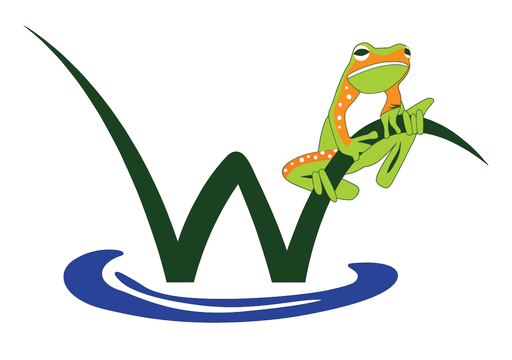The cacophonous and often noisy sounds of our Aussie amphibians – from the revving of the motorbike frogs to the strum of the banjo frogs and the grumpy wails of the moaning frogs, make our wetlands come alive! Little do we realise that the presence of these critters is an important sign of the good health of our wetlands.
We are blessed with a unique frog diversity with over 200 frog species calling Australia their home. Alarmingly, more and more of them are dwindling and now over 43 of them have been documented to be critically endangered and 3 seemingly extinct. Everything from human activity, urbanisation, urban encroachment and habitat loss, pollution and litter, clearing and draining of wetlands, and introduction of toxic chemicals, pesticides and fertilizers, is affecting them.
By building a frog pond in your backyard you are ensuring that these happy hoppers get a chance to beat the odds and survive. Plus, a healthy frog pond means that all is well with your garden. They will keep pests and insects in check by feeding on them. The frog pond will go a long way in enhancing the beauty of your otherwise ordinary backyard, and in bringing the lively sounds of the wetlands a little bit closer to home.
Our frogs spend more time in the bushland and return to the wetland to breed. If you can’t have a frog pond, a native garden, native plants, logs, mulch etc. will support them too!
Few caveats to begin with
Although frogs appear to be hardy, native frogs can be sensitive to their environment. Here are a few considerations to make while keeping our new friends:
- Frogs can be extremely noisy. Consider this before beginning construction. You may also want to talk to your neighbours and adjust the location of your frog pond accordingly.
- Do not use pesticides, fertilizers or other strong chemicals. These may impact your frogs’ food source.
- Avoid using exotic, non-native and invasive plants, such as amazon frogbit and water hyacinth, in and around the frog pond. Instead, use native species that the frogs love.
- Avoid adding “exotic” fish to your frog pond as these can predate on frogs, especially tadpoles and eggs. However, it may be beneficial to include some native fish, such as the Western Pygmy Perch or the Swan River Goby, as they are non-invasive as well as help in controlling mosquitoes by feeding on their larvae.
- Frog ponds may attract snakes, skinks and other reptiles. It is best to practice caution and be aware of these creatures’ presence while accessing the backyard. Consider covering the pond top with mesh or wire-fencing the pond to safeguard children.
Construction of your frog pond
Frogs need ample moisture, adequate food and some shelter. Consider these aspects while designing and constructing your frog pond. The pond itself doesn’t need to be very large for these tiny critters to feel safe and sheltered.
Sunlight is an important consideration to make. Without enough sunlight the tadpoles may not metamorphose in a season. So, the placement of your pond should be such that it receives a good amount of sunlight and some shade. Choose a location with about 70% shade and 30% sun. (And, a one-third sun during winters and a dappled sun during the summer months.)
For materials, everything from concrete to fibreglass works and pre-cast or prefabricated ponds are available in shops. Although it is essential to get PVC and UV stabilised liners for these.

Creating a comfortable home
To create a comfortable home for our frog friends, place gravel, rocks and logs in and around the pond. Frogs are ectothermic and rely on the external environment to control their body temperature i.e. if it’s cold they will try and find a sunny spot to bask and if it’s sweltering hot, they will then find a cool shady spot to relax. Make sure that variations of sunny and shady spots are available to them around their habitat throughout the year.
Ensure the walls of your pond are not too steep or slippery, as some frogs can get stuck and drown in the water. The pond must have sloping sides for frogs to easily navigate and manoeuvre around as well as move in and out of the pond. Fashion ramps made of wood or plastic or collect rocks and pebbles around the edges. If gardens are attached to the bush and attract bobtails, they too need these exit ramps to avoid falling in and drowning.
Fringing and aquatic vegetation is essential to their survival. A leaf litter and algae often safeguard tadpoles and fringing vegetation provides shelter and habitat for frogs. Use rushes, sedges, hostas and ferns to create an enclosed and safe habitat.

Attracting frogs to your pond
Once you have built your perfect pond, it may still take a while for it to become well-established and for froggies to come find it. Don’t be disheartened. Have patience!
It is important that you don’t import frogs from elsewhere into your pond, rather wait for local native species to find it. This is an important step in preserving the genetic integrity of the local gene pool. The local motorbike frogs can smell water from a great distance and will be the first ones to arrive.
Note that catching tadpoles or frogs from local water sources is illegal!
There is a local tadpole exchange program happening through the Western Australian Museum. Also, the national “Frogs Australia Network” database can be an invaluable resource while finding resident frogs through their tadpole exchange program. And, heaps of useful information on frogs and frog calls can be found here.

Should the frogs still be hesitant in arriving, here are a few tips for making your frog pond more attractive to the shy critters:
- Avoid keeping the pond too clean and tidy. Preserve the natural rustic state of the pond along with healthy leaf litter and organic matter. Insects and other organisms will thrive in such an environment and so will the frogs that in turn feed off them.
- Skip any fountains, filtration systems or waterfalls that you may want to add. Frogs like quiet, still and undisturbed waters.
- Create damp and cool crooks and crannies and wet areas around the pond. Use terracotta pots and planters, bricks, dead logs, driftwood, pebbles and stones, mulch and other materials. Frogs will often hide and take shelter in these spots you create.
Frog Pond at Norm’s Garden at The Wetlands Centre
If you’re seeking inspiration for your own frog pond or are simply looking for a spot to observe the happy hoppers in action, Norm’s Garden at The Wetlands Centre Cockburn may be perfect for you.

Norm’s garden is a water-wise garden developed using sustainable gardening practices and named after “Norm Godfrey”, a wetland visionary and poet.
Our frog pond is overflowing with tiny critters that aren’t too shy to make some noise on a good day. Or, come down to the Centre for our frog night stalk where we uncover the delightfully raucous sounds of frogs calling through the dense cover of the night.
References
- Black, D. (2019). The Amphibian Research Centre at Frogs.org.au. Retrieved 20 August 2019, from https://frogs.org.au/
- My Backyard » Frogs. (2019). Mybackyard.info. Retrieved 21 August 2019, from http://mybackyard.info/backyardblog/?cat=4
- Ponds, B. (2008). Backyard Frog Ponds. GARDENING AUSTRALIA. Retrieved 21 August 2019, from https://www.abc.net.au/gardening/factsheets/backyard-frog-ponds/9428752
- Frog bog and pond basics | Sustainable Gardening Australia. (2019). Sustainable Gardening Australia. Retrieved 23 August 2019, from https://www.sgaonline.org.au/frog-ponds/
- Oz Watergardens – the know-how on frog pond design. (2019). Ozwatergardens.com.au. Retrieved 23 August, from http://www.ozwatergardens.com.au/frog-ponds
- Frogs – Natural Resources Adelaide and Mount Lofty Ranges. (2019). Naturalresources.sa.gov.au. Retrieved 3 September 2019, from https://www.naturalresources.sa.gov.au/adelaidemtloftyranges/plants-and-animals/native-plants-animals-and-biodiversity/native-animals/frogs


I have a pond and many motorbike frogs for many years! This year a male and female motorbike frig have decided swimming around in my chlorinated pool is a fun thing!! I have scooped them out and put them back in the pond but they keep going back in!! What can I do!!!
It sounds like your motorbike frogs are having quite the adventure! While they may enjoy your pool, the chlorine can be harmful to them over time. You could try setting up a pool escape ramp for critters (easily available in swimming pool or pet stores and online) to help them safely climb out if they fall in. Additionally, creating a barrier or covering your pool when not in use can keep them out. You might also make your frog pond a more appealing space for them by adding plants or logs, encouraging them to stay in their natural habitat.
Feel free to reach out if you need more advice on frog-friendly solutions!